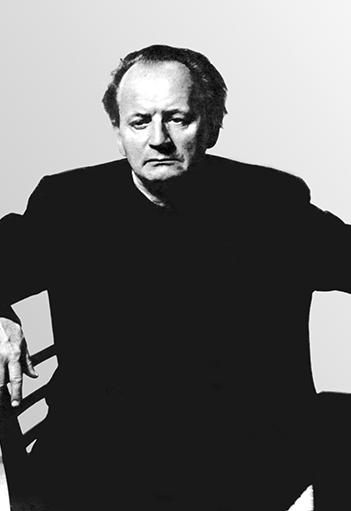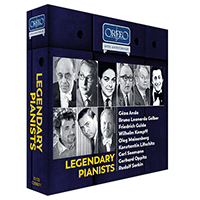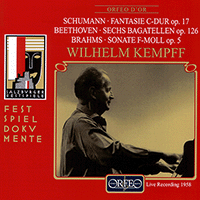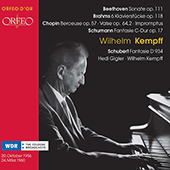Wilhelm Kempff
Wilhelm Kempff came from a family of Lutheran church musicians, his father being an organist who was transferred to Potsdam in 1899. Wilhelm’s first lessons in music were given to him at the age of five by his father, and at six he began piano lessons with Ida Schmidt-Schlesicke. At nine, Kempff so impressed the director of the Berlin Singakademie that he contacted Joseph Joachim, the great violinist, who awarded Kempff a scholarship to study at the Hochschule fur Musik in Berlin. Here he studied composition with Robert Kahn, and piano with Heinrich Barth, a pupil of Hans von Bulow and teacher of Arthur Rubinstein. At the age of fifteen Kempff enrolled at the Viktoriagymnasium in Potsdam to complete his academic tuition; at eighteen he returned to the Hochschule fur Musik in Berlin and also read music history and philosophy at the University. At the completion of his music studies Kempff was awarded two Mendelssohn Prizes, one for piano, the other for composition.
Kempff went on tour in 1916 with the Berlin Cathedral Choir, for whom he played the organ and piano. His solo piano performances were so popular in Scandinavia that he was invited to return. In 1917 he gave his first solo recital at the Singakademie in Berlin playing Beethoven’s ‘Hammerklavier’ Sonata Op. 106 and Brahms’s Variations on a theme by Paganini Op. 35. The following year he appeared with the Berlin Philharmonic and conductor Arthur Nikisch, the first of many collaborations with these artists. For the next few years he toured in Germany and Scandinavia, and in 1924 succeeded Max Pauer as director of the Musikhochschule in Stuttgart. In demand as a teacher, Kempff taught summer classes in the Marmorpalais in Potsdam where fellow teachers included Edwin Fischer and Walter Gieseking. Kempff played in Turkey in 1927 and in 1934 arrived in South America on the airship Graf Zeppelin.
During the 1930s Kempff gained a reputation for the performance of Beethoven’s piano sonatas, playing them throughout Europe, Scandinavia, South America, the Far East and Japan. In fact, from 1936 onwards, he regularly visited Japan. It was not until 1951 that Kempff made his London debut at the Wigmore Hall. He was fifty-six years old and chose to play Beethoven’s Piano Sonata Op. 111, Schubert’s Piano Sonata in B flat D. 960 and Liszt’s Deux Legendes. His playing was described as combining ‘…the limpid touch, vivid, precise phrasing, and sensitivity to musical incident of a highly intelligent musician with the “hair and fingertips” enthusiasm and grandiose theatricality of the Victorian keyboard lion’. In London two years later he played Beethoven’s ‘Hammerklavier’ Sonata Op. 106 and Bach’s ‘Goldberg’ Variations BWV 988, and his liking for programmes of large masterpieces would prompt him to often programme late Beethoven sonatas with works such as Brahms’s Piano Sonata in F minor Op. 5 and Schumann’s Fantasie in C major Op. 17. In concert, Kempff was apparently uneven, sometimes affording unforgettably wonderful experiences, but at others, plain disappointment. Alfred Brendel said, ‘…he can be so variable – more so than any other great artist I know.’ However, Kempff approached the Classical and German Romantic repertoire with the intellectual perception of the generation that followed him, yet he had the richly beautiful sound of the nineteenth-century pianists combined with a noble style of visionary delivery that was in no way histrionic. He continued to perform into his eighties, but his final concert was in 1981 as during his last decade he suffered from Parkinson’s disease.
Kempff was also a composer and as such was elected to the Prussian Academy of Arts in 1932. His Symphony No. 1 was written in 1915, and in 1924 Wilhelm Furtwangler gave the premiere of the Symphony No. 2 at the Leipzig Gewandhaus the year after it had been written. Aside from orchestral works, oratorios, chamber music, a violin concerto and a piano concerto with chorus, Kempff wrote three operas: Konig Midas in 1930, Die Familie Gozzi in 1932 and Die Fasnacht von Rottweil in 1935. He also wrote two volumes of autobiography: Unter dem Zimbelstern (1951) and Was ich horte, was ich sah (1981).
During the whole of Kempff’s recording career, a period of more than sixty years beginning in 1920, he made discs for Deutsche Grammophon. Most important are his recordings of the complete Beethoven piano sonatas which he recorded three times. The second and third versions were complete, and the third version in stereo from the mid-1960s is generally held to be the best; his recordings of these works were, for a new generation, what Schnabel’s were to listeners of the 1930s. He recorded the Beethoven piano concertos twice, and again the later version with the Berlin Philharmonic and Ferdinand Leitner is often preferred. Also of note are recordings of eighteen of Schubert’s piano sonatas, some late Brahms pieces and some Schumann, Bach and Mozart. In the 1950s Kempff recorded for Decca music by Bach, Liszt, Chopin, Brahms, Schubert and Schumann. The two Liszt piano concertos with Anatole Fistoulari are ponderous and disappointing, whilst most of the Chopin reveals that Kempff did not have the technical equipment necessary for works such as the piano sonatas, the Scherzo No. 3 in C sharp minor Op. 39, and the Andante Spianato and Grande Polonaise Op. 22. The most successful of his Chopin recordings are those which have a visionary aspect, such as the Berceuse Op. 57 and the Barcarolle Op. 60.
Most revealing are the best of his live performances, some of which have been issued by BBC Legends. From June 1969 comes a recital given at the Queen Elizabeth Hall in London. Critic Bryce Morrison, after mentioning many of the great pianists he had heard, said of this concert, ‘Yet if I were to single out one musical experience that transcended all others, it would have to be Wilhelm Kempff’s 1969 Queen Elizabeth Hall recital.’ Kempff played Bach’s Chromatic Fantasy and Fugue BWV 903, Beethoven’s Piano Sonata in F major Op. 54 and a Schubert group including the Piano Sonata in F minor D. 625. Kempff, at nearly seventy-five years of age, was at the top of his sometimes unpredictable form. From the outset this is great piano playing that seems to unfold in the most natural of ways with a beauty of sound rarely heard today. Five months later Kempff gave another recital at the same venue which included Brahms’s Piano Sonata No. 3 in F minor Op. 5 and Schumann’s Papillons Op. 2 and Fantasie Op. 17. Also released by BBC Legends, this captures Kempff in two great nineteenth-century works for the piano. The Music & Arts label in America has issued a set of two compact discs containing German radio broadcasts from 1939 and 1945, and although Kempff recorded most of the repertoire featured in these later in his career, it is interesting to hear him in Mozart’s Piano Concerto in C major K. 467 in 1939.
© Naxos Rights International Ltd. — Jonathan Summers (A–Z of Pianists, Naxos 8.558107–10).



















